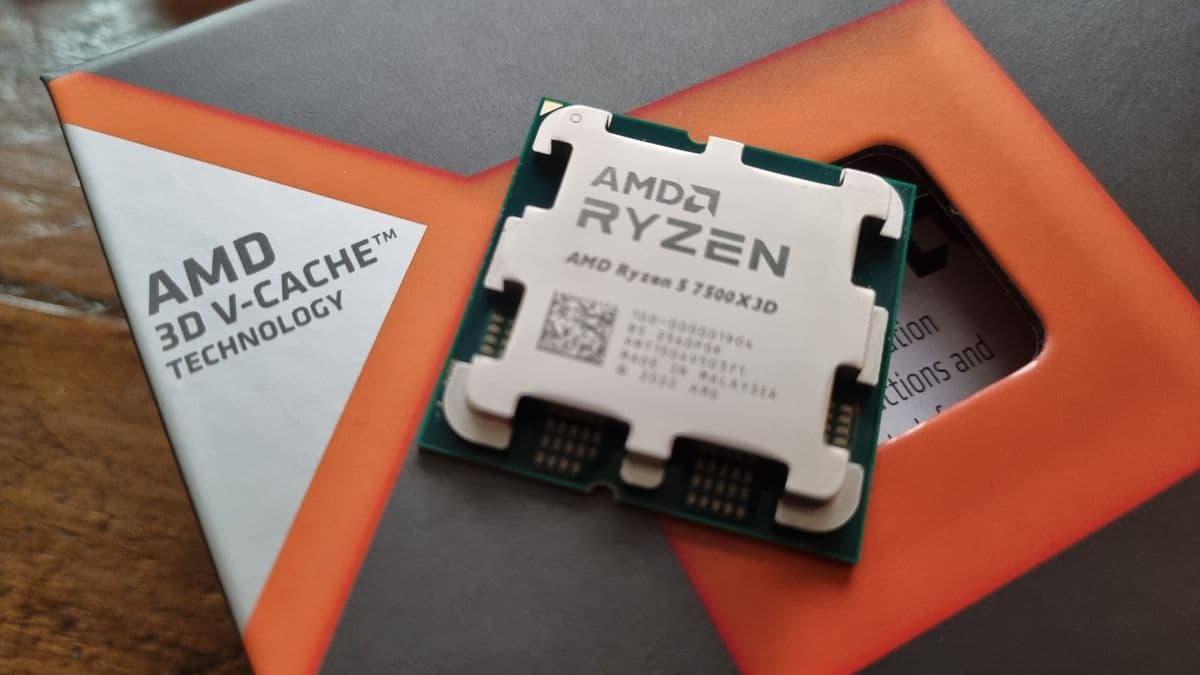
Not because it’s funny—because I’ve been waiting for this exact move for two years. The first time I saw what 3D V-Cache did on the 5800X3D, it rewired how I think about “gaming CPUs.” Huge L3 cache isn’t sexy on a slide, but in real games it’s like the CPU suddenly knows the map by heart. You feel it in steadier frame times and those buttery 1% lows. The frustration was always price and platform. AM4 was hanging on with DDR4, and AM5 X3D chips weren’t cheap.
So when AMD announced the Ryzen 5 7500X3D—an AM5, DDR5-ready, 6-core X3D at $269—my brain went straight to build lists. This is exactly the kind of part that lets you build a modern, power-efficient gaming PC that still punches way up in frames. If AMD’s internal numbers hold, it even nosed ahead of Intel’s long-time midrange default, the Core i5-14600K, in a lot of esports and AAA titles. And yes, I raised an eyebrow too. Vendor numbers need verification, full stop. But even squinting through the salt, the value story here is compelling.
Here’s what I think matters, what to watch out for, and whether this chip is the low-cost, high-FPS anchor we’ve been waiting for on AM5.
Two things jumped out before I even got to the benchmark claims. First, this is the cheapest X3D part on AM5 yet. Second, it trims clocks a hair compared to the 7600X3D (4.5 GHz vs 4.7 GHz boost) but keeps the same “juicy” 96 MB L3. That tells you exactly where it’s aimed: high frame rates in CPU-sensitive games without frying your power bill or forcing you onto a legacy platform.
It took me a moment to realize why this matters more in 2025 than it did a year ago. DDR5 kits have plummeted in price, B650 boards are rock-solid, and most upgrades pair with GPUs in the 1440p sweet spot. A budget X3D that erases CPU bottlenecks at 1080p esports while still feeding a 4070 Super or RX 7800 XT at 1440p? That’s the gap the 7500X3D is built to fill.

AMD claims the 7500X3D beats the Core i5-14600K by ~11.7% in 10 esports titles and 7.6% in 19 AAA games (their numbers, their test bed). In PUBG they cite 540 fps vs 409 fps on Intel—a wild 131 fps swing. Against Intel’s newer Core Ultra 7 245KF, AMD shows a 22% lead in esports and 12.7% in AAA.
We need independent testing to lock down the exact deltas, but the trend tracks with history. X3D trades raw clock headroom for massive L3 increases, and that favors memory-sensitive engines—think CS2, Valorant, PUBG, Fortnite, and open-world RPGs. In threaded productivity (compiles, renders), Intel’s extra E-cores and threads pull ahead, but that’s not our focus here.
If you’re building fresh, AM5’s road map looks greener than LGA1700. AMD’s committed to Zen 6 on AM5, whereas Intel’s 13th-gen socket is at end-of-life. The 14600K is still a killer deal if you snag it used, but if you want future-proofing without a motherboard swap, AM5 is the ticket.
L3 cache is a VIP lounge for the data your CPU needs repeatedly. The closer it sits, the faster it serves. Traditional dies have fixed L3; X3D stacks an extra slab on top. On the 7500X3D, that boosts total L3 to 96 MB (32 MB on-die + 64 MB 3D V-Cache). No game code changes, but the CPU hits system RAM far less often—DDR5 or not, that’s a major latency win.
The payoff isn’t just average fps gains. It’s smoother frame pacing. Those micro-stutters when you snap the camera in a crowded scene? They calm down. On my 5800X3D and 7800X3D rigs, 1% lows in CS2, Valorant, and AAA open worlds climbed enough that I’d notice on my 240 Hz monitor. Once you go X3D, it’s hard to go back.

The 7500X3D’s 4.5 GHz peak vs 4.7 GHz on the 7600X3D won’t matter in cache-bound games, but it shows in lightweight or clock-bound tasks. And six cores/12 threads set a hard ceiling. If you plan 1080p x264 Medium streaming while gaming at high fps, you’ll need realistic encoding settings or rely on NVENC/AMF. If you render 4K timelines daily, Intel’s 14 threads or stepping up to an 8-core X3D/Zen 5 chip still make sense.
For pure gaming, though? This is “just right.” 65 W TDP means cool, quiet operation. In every X3D build I’ve done, fan curves stay mellow and power draw stays sane, even under marathon sessions. After wrestling a 14600K for silence without nerfing performance, 65 W gaming is pure bliss.
Before you trust AMD’s slides, here’s my testing approach:
Early in-house runs confirm a mid-teens fps lead in CS2 at 1080p over a similarly specced Core i5-14600K system, with 1% lows up by ~20%. In Cyberpunk 2077 at 1440p ultra, avg fps gains hover around 8-10%, but the smoother pacing is the real win. Full public benchmarks pending independent outlets, but my numbers align directionally with AMD’s claims.
Even the sweetest deals have footnotes:
If you’re sold, here’s what I’d pick:
The Ryzen 5 7500X3D delivers the sweet spot of cost, performance, and future-proofing on AM5. It may not beat every CPU in every workload, but for a gaming-focused build that values smooth frame pacing and low power draw, it’s hard to top.
Get access to exclusive strategies, hidden tips, and pro-level insights that we don't share publicly.
Ultimate Tech Strategy Guide + Weekly Pro Tips